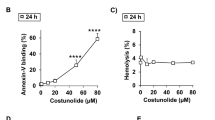Abstract
Ochratoxin A (OTA) is a mycotoxin produced by Aspergillus ochraceus as well as other moulds. This mycotoxin contaminates animal feed and human food and is nephrotoxic for all animal species studied so far. OTA is immunosuppressive, genotoxic, teratogenic and carcinogenic. Recently lipid peroxidation induced by OTA has been reported. OTA, a structural analogue of phenylalanine, inhibits protein synthesis by competition with phenylalanine in the phenylalanine-tRNA aminoacylation reaction, constituting the main mechanism of OTA-induced cytotoxicity. Since it seems impossible to avoid contamination of foodstuffs by toxigenic fungi, investigation is required for preventing the toxicity of OTA. An attempt to prevent its toxic effect, mainly the inhibition of protein synthesis, has been made using aspartame (l-aspartyl-l-phenylalanine methyl ester) a structural analogue of both OTA and phenylalanine. Protein synthesis was assayed in monkey kidney cells (Vero cells) treated by increasing concentrations of OTA (10–100 μM). After 24 h incubation, protein synthesis was inhibited by OTA in a concentration dependent manner (the 50% inhibitory concentration, IC50, was c.␣14.5 μM). Aspartame (A19), at tenfold higher concentrations than OTA (100–1000 μM), was found to partially protect against the OTA-induced inhibition of protein synthesis in Vero cells, and more efficiently when added 24 h prior to the toxin (IC50 34 μM) than together (IC50 22 μM). As expected A19(250 μM) prevented the OTA-induced leakage of certain enzymes, including lactate dehydrogenase, γ-glutamyl transferase, alkaline phosphatase, into the culture medium, and the concomitant decrease of their intracellular activity in OTA (25 μM)-treated cells. In order to investigate the effect of aspartame (A19) on OTA-protein binding as explanation of the above results, the mycotoxin time- and concentration-dependent binding to human samples was studied in static diffusion cells with two compartments separated by a dialysis membrane. When A19 (34 μM) was added to the upper compartment containing plasma before installing OTA (50, 250, 1240 μM) in the lower one, OTA binding was largely prevented (95–98%). When A19 (34 μM) was added to the lower compartment simultaneously with the toxin (50, 250, 1240 μM), for the lowest concentration of OTA, the same efficiency was shown in preventing OTA binding, but at the two high concentrations A19 seemed less efficient.
Similar content being viewed by others
Author information
Authors and Affiliations
Additional information
Received: 9 July 1996 / Accepted: 1 October 1996
Rights and permissions
About this article
Cite this article
Baudrimont, I., Betbeder, A. & Creppy, E. Reduction of the ochratoxin A-induced cytotoxicity in Vero cells by aspartame. Arch Toxicol 71, 290–298 (1997). https://doi.org/10.1007/s002040050389
Issue Date:
DOI: https://doi.org/10.1007/s002040050389




